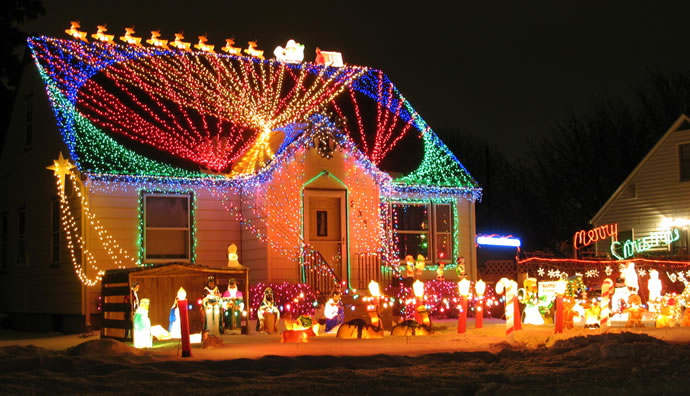
Here at Root Electric, we love electricity and everything that goes with it, and that includes Christmas lights. What many people don’t understand, however, is that installing multiple strings of lights around their house and yard may be setting them up for short circuits, injuries and an electrical fires. According to the National Fire Protection Association (NFPA), an average of 150 homes are burned, with 8 people killed and 14 people injured every year due to incorrect use of holiday lights. Don’t let this happen to your home and family—before you deck the halls, the windows, the trees and the bushes with tons of lights, consider that you may actually need to install new circuits for Christmas lights, even if your decorating plans are modest, but particularly if you have more ambitious plans.
The first thing you need to do is understand the circuitry in your home so that you understand what your outlets can and cannot handle. The average receptacle circuits in your home can handle between 15-20 amps. You never want to go over 20 amps, obviously, but the safest rule of thumb is never to cross the 80% threshold, meaning that 16 amps is where you want to stop. The question you need to answer, however, is whether or not you have wiring capable of handling 15 OR 20 amps. Because if you try to put 16 amps over a wire that can only handle 15, you’re going to run into trouble. The wires and the breaker may start to overheat and cause a fire. Fortunately, the circuit breaker in your electrical panel will cut the power in the event of a short circuit—if it’s functioning properly. Not only might you need to have us install new circuits for Christmas lights—if you’ve noticed a lot of short circuiting lately, you should also have us look at the wiring and the electrical panel before you start plugging in the Christmas cheer.
Taking this a step further, you can mentally compute how many amps your electrical appliances (this includes Christmas lights) draw. This can help you understand, before you plug them in, whether or not the outlet can handle any more pressure. You can do this by dividing the wattage number by your voltage. For example: You plug a 1000-watt slow cooker into a 120 volt outlet. Rounding up, that’s a smidge under 10 amps, but if you can only handle 15 amps, you’re getting close to the safe limit already. So if you are planning a big light show, you need to consider what appliances you already have running on the same circuits so that you don’t overburden them. This is why installing dedicated new circuits for Christmas lights is a safer idea.
One last thing you will want to consider as you gear up for the holiday lights: you can save electricity by using newer LED lights over the standard holiday lights. They need far less electricity to glow.. Just to compare: One strand of 50 standard mini lights requires about 20 watts, while one strand of 70 LED mini lights doesn’t quite need 5 watts. That’s 20 extra lights, and a whole lot less power consumption. Depending on the condition and usage on your circuits already, you still may want to consider installing new circuits for Christmas lights.
Of course, installing new circuits for anything requires a professional residential electrician for safety purposes. The last thing you want is to have an electrical accident or fire over the holidays!
So call us at 703-494-3989 to have us come out and look at the situation and help you get ready for the holidays with new circuits for Christmas lights!
REQUEST A FREE QUOTE
Satisfaction / Safety First Since 1986
